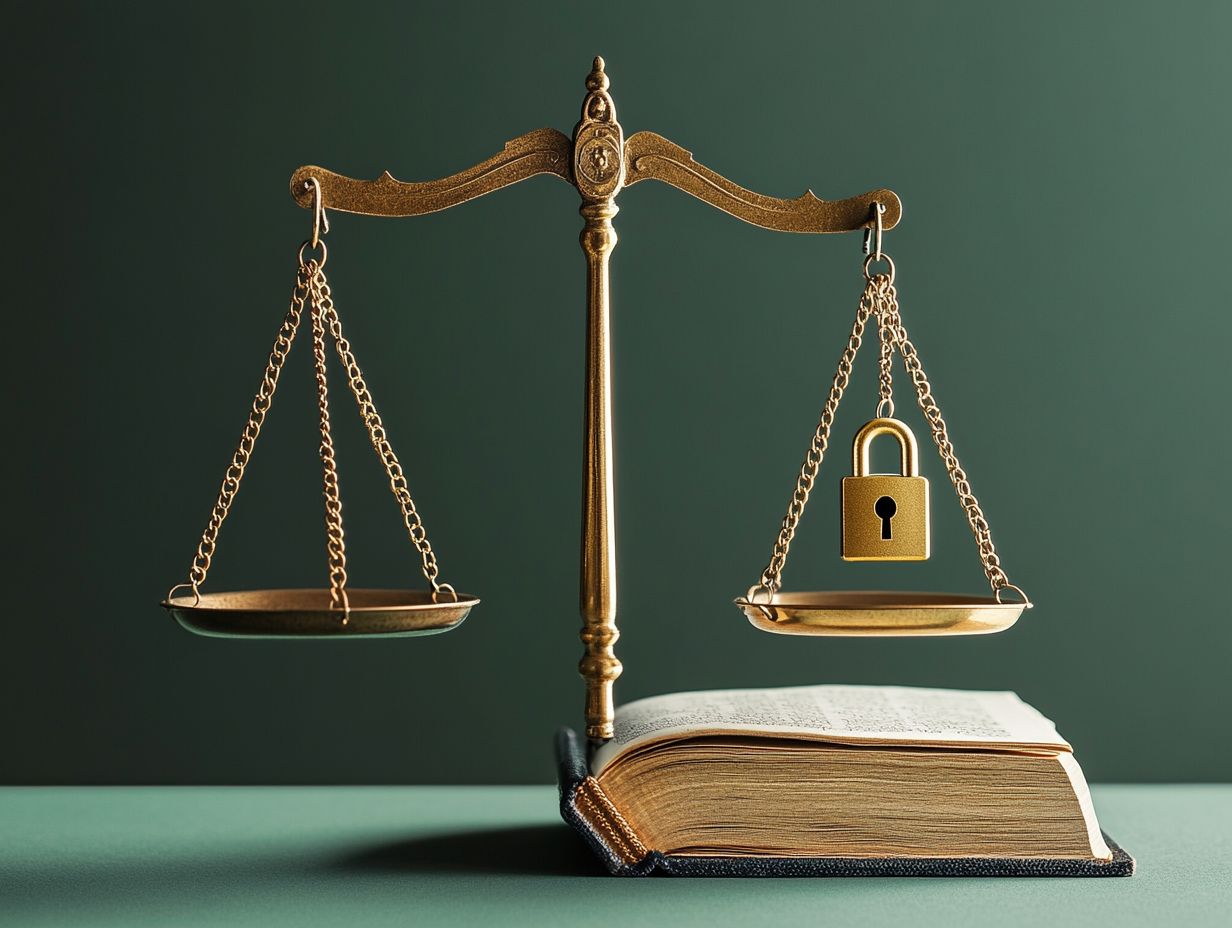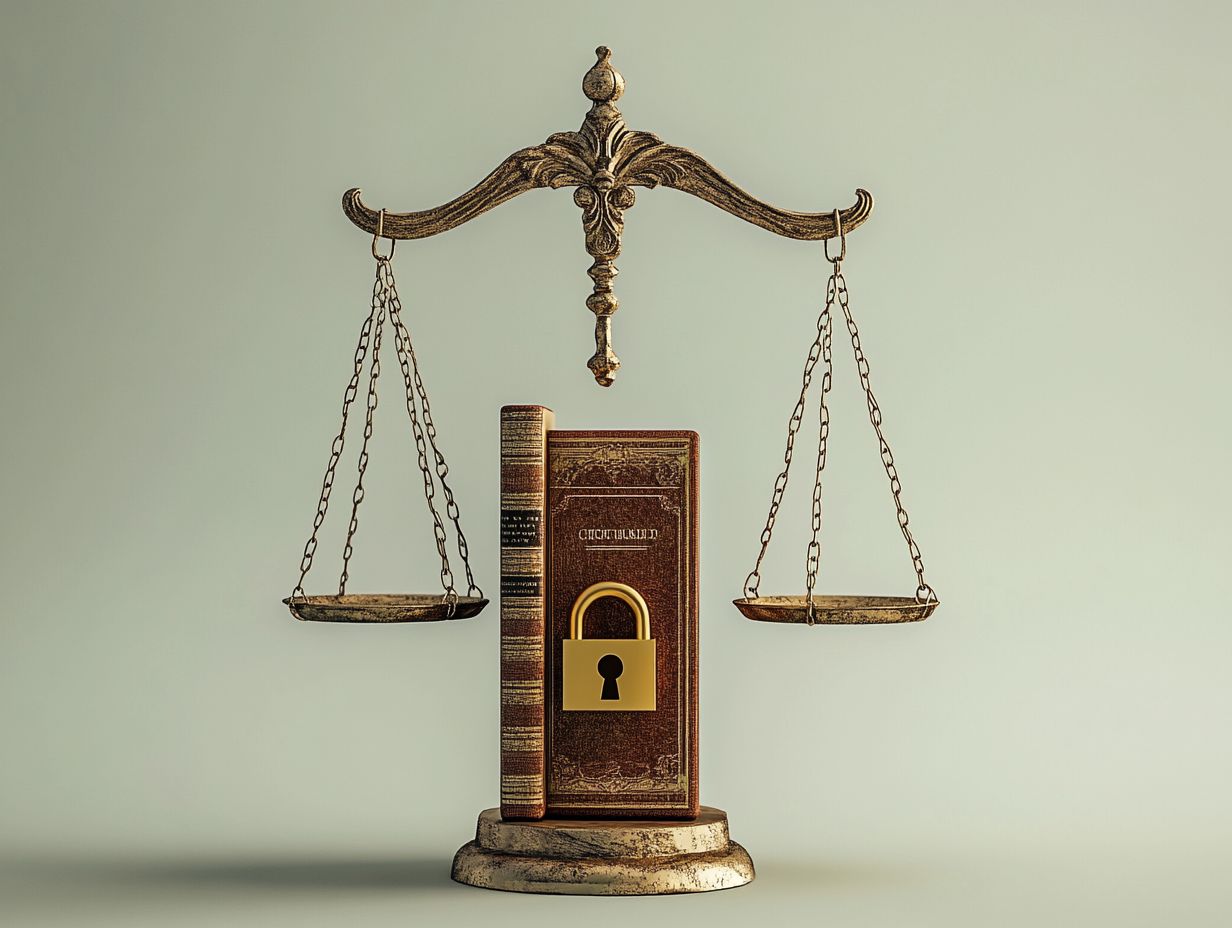The Relationship Between Trade Secrets and Copyrights
Navigating the intricate landscape of legal protections for creative ideas and inventions can feel overwhelming, especially when trying to grasp the nuances of trade secrets and copyrights.
While both are crucial for safeguarding your creative assets, they serve distinct purposes and come with unique legal implications. This article highlights the key differences between these two forms of protection, explores how they can work in harmony, addresses potential conflicts, and offers best practices for safeguarding your valuable ideas and creations.
Dive into these essential concepts and discover how to protect your valuable ideas!
Contents
- Key Takeaways:
- How Trade Secrets and Copyrights Differ: What You Need to Know!
- How Trade Secrets and Copyrights Complement Each Other
- Potential Conflicts Between Trade Secrets and Copyrights
- Best Practices for Protecting Trade Secrets and Copyrights
- Frequently Asked Questions
- What is the relationship between trade secrets and copyrights?
- Can something be both a trade secret and copyrighted?
- What is the main difference between trade secrets and copyrights?
- Do trade secrets and copyrights have different requirements for protection?
- When should I use trade secret protection and when should I use copyright protection?
- What happens if I don’t protect my trade secrets and copyrights?
Key Takeaways:

Trade secrets and copyrights are two distinct forms of intellectual property protection with key differences in legal protection and scope of rights.
Utilizing both trade secrets and copyrights can offer complementary benefits for businesses in terms of protection and enforcement, especially when considering the role of trade secrets vs. patents.
Potential conflicts can arise between trade secrets and copyrights, but these can be addressed through careful consideration and strategic protection measures.
Defining the Concepts
Understanding the fundamental concepts of intellectual property is essential for everyone, whether you re a business owner or an individual creator. This realm encompasses various legal rights designed to protect creative works, including trademarks, copyrights, and trade secrets.
Intellectual property rights guard your original works against unauthorized use and provide significant economic advantages for creators and innovators. Recognizing the nuances and intersections among these forms of protection is vital in today s competitive marketplace, particularly in sectors like technology and art, where unique creations can profoundly influence brand and market identity.
Each dimension of intellectual property serves a specific purpose tailored to your needs. For instance, trademarks help you distinguish your goods or services, enabling consumers to effortlessly identify their source. Meanwhile, copyright secures the expression of your ideas, covering everything from literature to music.
Trade secrets provide a protective barrier for your confidential business information, allowing you to maintain a competitive edge without the hassle of registration. On the other hand, U.S. patents grant you exclusive rights over your inventions within a regulated framework that fosters innovation.
By understanding these types and their associated legal mechanisms, you not only enhance compliance but also enable yourself and your business to leverage your creations effectively. This knowledge paves the way for growth and success in our increasingly digital economy.
How Trade Secrets and Copyrights Differ: What You Need to Know!
Trade secrets and copyrights play unique roles in the landscape of intellectual property, each providing distinct legal protections tailored to various forms of creativity and innovation.
Trade secrets are designed to protect confidential business information think formulas and algorithms while copyrights safeguard original artistic works, encompassing everything from literature to software programs.
Understanding these distinctions is essential for businesses aiming to craft effective strategies for ownership documentation and legal safeguarding.
Legal Protection and Scope of Rights
Legal protection for intellectual property encompasses a range of mechanisms that confer exclusive rights upon creators and owners, ensuring their intellectual creations remain shielded from infringement challenges.
Trade secret protection heavily relies on non-disclosure agreements and confidentiality practices, while copyrights require registration processes to effectively assert ownership and rights.
Mastering these mechanisms is vital for leveraging your innovations and establishing a solid market identity.
In the realm of trade secrets, it s essential to take proactive measures to preserve your competitive advantage. This includes meticulously documenting ownership and strictly managing access to sensitive information.
Copyrights provide a clear way for you to register your works, granting you exclusive rights to reproduce, distribute, and display your creations.
Neglecting to adhere to these legal frameworks can lead to substantial losses of rights, potential legal disputes, and a decline in market standing. Thus, documenting ownership not only strengthens your claim over your intellectual property but also serves as a strategic advantage for standing out in a crowded marketplace.
Act now to secure your creative assets and stay ahead of competitors!
How Trade Secrets and Copyrights Complement Each Other

The relationship between trade secrets and innovation provides you with a sophisticated strategy for protecting your intellectual property while nurturing innovation.
By effectively leveraging both forms of protection, you safeguard your proprietary processes and creative expressions. This maximizes your economic benefits and secures a competitive edge in the marketplace.
This complementary relationship becomes especially evident in industries where confidentiality and creative expression are paramount.
Benefits of Utilizing Both Forms of Protection
Using both trade secrets and copyrights offers significant economic benefits and a substantial competitive edge. This dual approach protects your unique creations and boosts your bottom line.
Collaborating with an intellectual property attorney strengthens your protective strategies.
Take Coca-Cola and Google, for example. They harness trade secrets to safeguard their proprietary formulas and algorithms, ensuring their competitive edge remains unchallenged. Meanwhile, Disney skillfully employs copyrights to protect their beloved characters and stories, monetizing their intellectual property across various platforms.
By employing both strategies in tandem, you secure your innovations while cultivating brand loyalty and consumer trust. Intellectual property attorneys are essential in this journey, guiding you through the complexities of registration and enforcement so you can fully capitalize on your intellectual assets.
Potential Conflicts Between Trade Secrets and Copyrights
Navigating the intricate landscape of potential conflicts between trade secrets and copyrights is paramount for organizations aiming to avoid infringement claims and secure robust protection for their intellectual property.
Such conflicts frequently emerge when the boundaries of rights overlap. This can result in market confusion about ownership and usage rights. Grasping these nuances is essential for effective risk management in the realm of business law.
Addressing Overlapping Rights and Infringement Claims
Addressing the overlapping rights between trade secrets and copyrights is crucial for establishing effective legal protection and minimizing the risk of infringement claims. Implementing non-disclosure agreements (legal contracts that keep information private) and meticulously documenting ownership can clarify ownership rights and prevent disputes.
Understanding the legal landscape allows you to navigate these complexities with greater ease. Integrating effective strategies, such as detailed contractual agreements, solidifies your stance on intellectual property rights.
Act now to educate your employees about the importance of confidentiality! This fosters a culture of respect for proprietary information and strengthens your organization s integrity.
For example, a tech firm that consistently updates its non-disclosure agreements has successfully protected its innovations from unauthorized use.
Real-world examples demonstrate that by creating robust legal frameworks and encouraging open communication, you significantly reduce the likelihood of infringement claims while maintaining a competitive edge in your market.
Best Practices for Protecting Trade Secrets and Copyrights

Implementing best practices for safeguarding trade secrets and copyrights is crucial for protecting your intellectual property and maintaining a competitive edge.
Effective measures at your disposal include:
- Utilizing non-compete agreements
- Registering trademarks
- Formulating comprehensive strategies for securing confidential information
These practices not only bolster your legal protection but also help cultivate a strong market identity, setting you apart in your industry.
Strategies for Safeguarding Intellectual Property
Safeguarding your intellectual property is essential. It involves understanding your legal rights and taking proactive steps to protect your unique creations.
By using licensing agreements and strong legal rules, you can gain economic benefits. These strategies help reduce legal disputes and strengthen your brand identity.
Regular audits are crucial. They help identify vulnerable assets and ensure that employees are trained in IP awareness.
Working with intellectual property consultants can be beneficial. They can tailor protection strategies and guide you in trademarking your brand names and logos.
Adopting a multi-faceted approach creates a strong defense against infringement. This not only protects your work but also shows stakeholders your commitment to innovation.
Frequently Asked Questions
What is the relationship between trade secrets and copyrights?
Trade secrets and copyrights both protect intellectual property but serve different purposes. Trade secrets protect confidential info, while copyrights protect original works.
Can something be both a trade secret and copyrighted?

Yes, a company logo can be both a trade secret and copyrighted.
What is the main difference between trade secrets and copyrights?
Trade secrets protect confidential information, while understanding the relationship between trade secrets and corporate culture can further enhance their effectiveness. In contrast, copyrights safeguard original works of authorship.
Do trade secrets and copyrights have different requirements for protection?
Yes, protecting trade secrets requires keeping info confidential. Copyrights need the work to be in a tangible form.
When should I use trade secret protection and when should I use copyright protection?
Use trade secret protection for confidential info like recipes. Opt for copyright protection for original works like books or music.
What happens if I don’t protect my trade secrets and copyrights?
If unprotected, your trade secrets may be exposed, and your copyrighted works could be used without permission. Protecting your IP is crucial.






